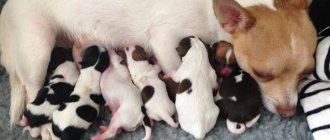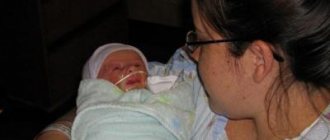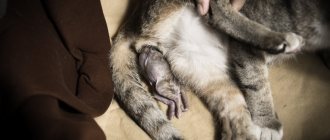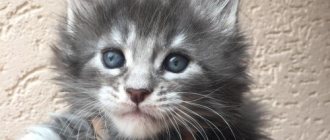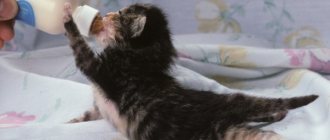Owners who own a furry lady need to decide whether they will breed her offspring. This question is very serious, since cats are living beings, and if the kittens turn out to be of no use to anyone, then the owners will be responsible for their lives.
And this is not the only difficult question. Yes, first of all, you need to find a new home for small pets, but that’s not all. There are other questions worth considering: is your furry lady able to give birth to healthy children? What is her age? Is she in good health? What kind of life does she lead? Will you be able to care for and provide for your cat throughout pregnancy and after birth?
If, nevertheless, the issue is resolved and the pet’s owners will breed charming babies, then before committing to mating, it is necessary to thoroughly study the pregnancy history.
Typically, pregnancy from fertilization to birth lasts approximately 62 days in cats. But it also depends on the breed, for example, a Siamese cat bears babies a little longer. Just like humans, animals do not have a specific birth date. For this reason, owners should expect that the birth of kittens may occur either earlier or later. See the exact gestational age in cats.
Clickable
Cat pregnancy duration chart, generally 65 days
Below, you will find out what happens during each stage of a cat's pregnancy.
Signs of pregnancy in Scottish cats
Scottish Folds are a very sweet, kind and affectionate breed. Soft plush wool will not leave any lover of meowing pets indifferent. Scots often win exhibitions and receive medals. Both adults and kittens. But the offspring must be healthy and beautiful, for which the cat must be properly cared for and carefully delivered.
The Scottish Fold becomes ready for mating at approximately 8 - 10 months. But it is best to wait until later in life to avoid a weak litter or miscarriage. The body must fully strengthen.
Before mating, the cat’s body must become stronger
If you are not going to breed kittens, then you can sterilize after the first heat (but older than six months). In this case, you will not have to worry about an accidental pregnancy.
The first signs of pregnancy begin in the second or third week after mating. The first symptom is morning sickness, just like in a woman. In addition, the cat’s nipples turn pink and the hair around them falls out. But such changes can not be observed in everyone. You can find out if your pet is definitely pregnant with an ultrasound examination. The first time the procedure is carried out in the third week after mating.
Nipples become swollen and pink
Characteristic signs may also include:
- Lethargy.
- Decreased or increased appetite.
- Tastes change.
- The cat cuddles more.
- Weight increases.
- Enlargement of the abdomen (at 5-6 weeks).
- Heavy breathing (in later stages).
Lethargy is one of the signs of pregnancy
When pregnancy is confirmed, it is worth isolating the Scottish one from communication with other animals, especially sick and street children, try to hold her less, but do not forget about affection. Take care of the room climate so that the cat does not catch a cold. Never use any medications without the advice of a veterinarian. You should not squeeze the expectant mother too much when trying to detect pregnancy. Embryos can be damaged. When cleaning, do not use strong chemicals that leave a pungent odor. A cat can become poisoned and not bear offspring even in the early stages. Contact the cat only with well-washed hands, and keep it away from dirty floors in the hallways.
Number of births for a cat
Pregnancy is possible after every heat, and the latter depends mainly on the health and living conditions of the cat. If a mustachioed couple does not leave the apartment, their biorhythms are disrupted, and such “lovers” will go for walks more often than expected. A cat can kitten up to 3 times a year. However, the optimal amount would still be once a year. Too frequent childbirth depletes the cat's body and contributes to the breeding of weak offspring.
Nature has invested a lot of skill and strength in mustachioed pets in order to cope with such a difficult matter as pregnancy. But the owner’s control and broad outlook will never become superfluous helpers.
Tartan Pregnancy Calendar
In short-haired breeds, pregnancy lasts less than in long-haired breeds. The Scottish cat's pregnancy takes approximately 65 days. The duration of gestation depends on the number of kittens.
There is no difference in pregnancy between straight-eared and fold-eared breeds.
But for any female, the period is divided into three stages.
1 phase
I – III weeks. The pet's behavior changes. May almost completely refuse to eat. At this moment you need to be more affectionate with the cat and surround it with care. Embryos reach 10 mm, the skeletal system, brain, and organs develop.
During pregnancy, the cat loses her appetite
2 phase
IV – VI weeks. The torso of the expectant mother is rounded, and the offspring can be felt with your hand. Appetite and weight increase. The nipples are getting even bigger. Embryos are becoming more and more like kittens. The detailed formation of the body takes place. Monitor your cat's activity as body changes may cause her to become clumsy and cause injury to herself. Take care of your safety. Do not leave access to places where you can jump.
The torso is rounded in phase 2
3 phase
VII – IX weeks. The cat's activity decreases completely and spends a lot of time sleeping. May wander around the apartment in search of a cozy place to give birth to offspring. Prepare in advance a comfortable bed for the cat and her future cubs. Limit the amount you eat. Watch your cat constantly. The exact moment of birth is difficult to predict. By birth, kittens reach at least 10 cm. The skin becomes stronger, and the legs and tail lengthen. Fur and color appear. The weight of babies ranges from 60 to 140 grams.
The cat becomes tired and rests a lot
Mature kittens can be seen on x-rays.
How to recognize the onset of labor
Inexperienced owners worry more than their pets. They ask in advance how to understand that a cat has started giving birth, and how long to wait for the kittens to appear. Veterinarians advise monitoring the behavior and well-being of your pet throughout pregnancy. This will help you easily recognize changes at an early stage.
Behavior of the expectant mother
The first signs of labor in a cat involve behavior. The expectant mother is nervous, anxious, constantly looking for a secluded corner and trying to build a nest. Because of this, it is important to accustom her to a prepared box in advance.
A pregnant woman's appetite decreases to the point of hunger strike. She constantly licks the external genitalia, and a few hours before lambing begins to arch her back. With a strong attachment to the owner, the animal begins to attract his attention by meowing.
Physiological signs
Physiological signs include swelling of the mammary glands, the appearance of lactation and a decrease in body temperature to 37 °C. The pregnant belly drops and takes on the shape of a pear. The frequency of going to the toilet increases. 1-2 days before the onset of labor, the mucous plug comes off. It is difficult to notice the passage of water, since the secreted mucus is constantly licked out.
Pregnant cat diet
In an interesting situation, the cat should eat more and better. Dry food must be super premium. Portions are increased by half from the end of the first phase. The expectant mother should receive more fat to produce milk. You should not allow your pet to become obese. With such a disease, childbirth will be more difficult. By the end of the third phase, the portions return to the initial volume.
It is recommended to add additional vitamins to the food, but only on the recommendation of a veterinarian.
Canned food is added to dry food and by the end of gestation the food should be completely wet. A pregnant cat can be given the same food as for kittens. Since there are no special foods for pregnant women, all the necessary vitamins can be found in food for babies.
Baby food suitable for pregnant women
If the pet’s diet consisted of natural food, then the following products should remain on the menu: boiled lean meat, boiled vegetables, boiled eggs, lean boiled fish (but only in small portions). To improve digestion, add beet puree.
As for the liquid, in addition to constantly clean water, make a decoction of raspberry leaves for breakfast and dinner. The infusion will make childbirth easier. A nettle salad (the leaves need to be doused with boiling water) will help the formation of milk.
Diagnosis of pregnancy
Formally, ovulation occurs 24-30 hours after mating. For convenience, breeders calculate the total cycle length as the difference between the day of birth and the day of mating. On average, gestation of kittens lasts 62-68 days. The longest period is typical for the Siamese-Oriental group. These cats have offspring only 71 days after mating. How to determine if a cat is pregnant?
An earlier and more accurate diagnosis of a cat’s pregnancy can be done in the clinic using imaging studies:
- ultrasonography
- radiographic examination
Ultrasound can reliably diagnose a cat's pregnancy from the 20th day, and this method also allows you to monitor the development of the fetus throughout the pregnancy. The only parameter that is often impossible to determine using this type of study is the number of fetuses, especially in multiple pregnancies. The second method of visual diagnosis is radiography. This study is relevant no earlier than 4-5 weeks, since until this moment the bones of the fetus contain a small amount of minerals and are poorly visualized on an x-ray.
The most accurate method for determining pregnancy
X-ray allows you to confirm a cat’s pregnancy if it is not possible to conduct an ultrasound examination (there is no equipment in the clinics closest to you) and palpation is difficult (for example, the animal is aggressive or very obese). Also, using an x-ray, you can more accurately calculate the number of fetuses.
Pregnancy screening for cats
A veterinarian should check to see if your cat is pregnant. When examining cats, an assistant should hold the animal in a lying position. To do this, take the fold of skin near the back of the head with the right hand, and with the left hand grab both hind limbs in the metatarsal area, place the cat on the table and stretch it slightly so that it cannot squirm and scratch with the forelimbs or bite. The cat is held in a dorsal position and palpated through the abdominal wall with one hand.
For palpation, grasp the abdominal wall between the thumb and other fingers at the level of the lumbar vertebrae and gently squeeze the fingers. The rectum is often palpated here if it is filled with feces. Trying not to weaken the pressure of the fingers, move them down. At the same time, in non-pregnant cats, uterine horns are sometimes found, diverging in the form of elastic cords. In pregnant cats, uterine ampoules or fetuses are found.
Palpation by a veterinarian
What is not allowed in an “interesting position”?
If the cat has been walking outside, then during gestation it should be fenced off from the street so that the cat does not get an infection or parasites.
You cannot overcool a cat or treat it with tablets and other means without consultation from a veterinary clinic. This can cause great harm to the offspring.
Don't let your cat get sick during pregnancy
The cat should be in a calm environment. Avoid stress. Surround with affection and care.
Monitor your cat's activity. She should not move too quickly, as there is a possibility of falling or colliding with some object, which could cause injury to both the cat and the fetus.
Why detect a cat's pregnancy in the early stages?
Despite the fact that a cat's body is designed to survive in the wild, care and monitoring of pregnancy are very important. The sooner the owner finds out that she is pregnant, the more time she will have to prepare for the arrival of the babies. For your information! The ability to bear kittens occurs at different ages in each breed. For example, British cats are ready for their first pregnancy only after 1 year of life. It is especially important to monitor the condition of purebred animals (for example, sphinxes, folds). Some breeds may have difficulties during pregnancy and birth. In addition to being monitored by a veterinarian, owners must be able to independently handle the cat during labor if assistance is needed.
I am pregnant?? - Can't be…
How to prepare for and deliver a baby
Scottish cats are an artificially bred breed of cat. The instincts of breeds with wild roots, which could completely cope with childbirth themselves, are weaker in this breed. Therefore, the cat may need help in this difficult matter.
First of all, take care of the place for childbirth. Make a soft, comfortable bed in a dark, quiet place. Place the woman in labor in this place. If the birth occurs in another unexpected place, then move the cat and kittens to a constructed crib.
Don't forget to keep clean towels, medical gloves, hydrogen peroxide or chlorhexidine, pipette, thread and scissors, Vaseline, iodine nearby.
At the very beginning of labor, when the cat is clearly breathing heavily, a colorless discharge appears. Next you can see the kitten's head and shoulders. If the attempts are weak, help the baby get out by gently pulling the withers. The lump comes out in the amniotic sac, which bursts on its own. If the bubble does not burst, you need to break it, separate it from the kitten, shake the baby and remove the liquid remaining in the mouth with a pipette. Hands must be clean and lubricated.
Childbirth is performed with sterile gloves
Then the placenta comes out (if this does not happen, you need to extract it yourself). Usually the cat will chew the umbilical cord, but this may not happen. In this case, cut it yourself, after tying it with thread. Treat the incision with iodine. Place the first kitten near the cat's nipples. Dry the kitten with a clean towel. After about 25 minutes the next baby appears. Carry out the same procedures.
The kitten is placed on the mother's nipples
After giving birth, the cat eats the placenta; you cannot eat more than two pieces. Replace with food. All placentas are delivered about half a day after the birth of all kittens. If there are fewer of them than kittens, then you need to contact a veterinarian to avoid inflammation.
In case of a difficult birth, you should call a veterinarian.
The first litter can have 1 – 3 kittens. In subsequent births, more kittens appear and can reach eight lumps.
Over time, there are more kittens in the litter
How to tell if your cat is about to give birth
As birth approaches, the cat becomes more and more lethargic. She eats less and licks her genitals more often. In the week before giving birth, the animal follows its owner more often and also begins to look for a convenient place to give birth. Cats usually try to find a protected space, so it makes sense to set it up personally to prevent the cat from giving birth somewhere under the bathtub.
This is due not only to unsanitary conditions, but also to the fact that it is cold there and it will be very difficult to clean after childbirth. In addition, you cannot be sure that kittens will not inhale the cleaning products that are often stored there.
The best options would be either the bottom drawer of the chest of drawers or a cardboard box of a fairly large size with high sides. For example, a box of bananas, which you can ask for at any grocery store, will do. At the bottom of future nurseries it is worth laying soft bedding, such as towels or cut-up sheets.
Be prepared for the fact that you will have to throw away this litter later, as it will be covered in blood and amniotic fluid. After arranging this shelter, the cat will carefully examine it, dig around and, most likely, settle down there.
Just before giving birth, the cat will lie down on its side in a location of its choosing. She will breathe through her mouth, quite often. In rare cases, these animals give birth while sitting, with their legs spread apart, but this is the exception rather than the rule.
Important! If you have no experience in childbirth and you are scared, then it is best to call a veterinarian at home or bring your cat to a veterinary clinic. It is advisable to think through possible options in advance, where to turn and what to do in case of surprises.
Veterinarian about cat pregnancy:
Premature birth
Premature birth is considered any birth less than 60 days. You can save the offspring if birth occurs no earlier than 50–55 days. When labor begins a week early, kittens often die.
When can premature labor begin:
- If a cat has more than five kittens in a litter, then labor will begin earlier.
- If the animal catches the infection, then labor will begin prematurely.
- The duration is also affected by the cat’s build and age. Very young cats (up to a year) give birth on the 50th day, but the offspring are most often unhealthy.
- Small cats do not walk with a belly for more than 65 days.
- In Scottish women, normal labor takes place in at least 60 days.
- If a young cat gives birth early (at about 1 year), then labor takes up to 60 days. In this case, the offspring may also be unhealthy.
- Premature labor can begin due to a sudden change in temperature.
- Weak embryos die inside the womb, causing early labor.
- If the cat is very scared or nervous.
If your cat’s behavior has become strange or its condition has worsened, contact the clinic, where they will do everything necessary to help. You can remove the tone of the uterus to continue pregnancy, or induce premature birth or perform a caesarean section.
Due to a stressful situation, the cat may give birth earlier or the birth may be delayed.
How to care for a cat and kittens
Change the new family's diapers and leave them alone. Newborns have little fur, making it difficult for them to stay warm. Hang a lamp over the box to prevent them from freezing.
Cat food
A young mother feeds her offspring for up to 2-2.5 months. This requires a lot of effort, so pay special attention to her nutrition:
- Purchase quality food formulated for pregnant and lactating animals.
- Focus on fermented milk products. If you adhere to natural feeding, then take care of a sufficient amount of calcium. All other food should be easily digestible: boiled lean meat, vegetables, cereals. The amount of meat in the first 10-12 days is reduced to a minimum.
- Add magnesium and calcium to your diet. Additional nutritional supplements will be needed when eating natural foods. Before using medications, be sure to consult your veterinarian.
- Change the water regularly. Bacteria in the water will immediately affect newborns.
At first, the frequency of feeding increases to 4-6 times a day. Portions should be small and balanced.
A first-time pet often leaves her family due to poorly developed maternal instinct. Don't scold her, but calmly bring her back. After several returns, she will understand what is required of her.
Feeding kittens in the absence of milk
Mother's milk cannot be replaced with cow's milk. A cat's body can only digest milk of its own species. Consumption of milk from other animals is fraught with acute intestinal upset followed by dehydration. Also, with such feeding, there is a lack of essential nutrients. In the long term, there is a lag in development and the formation of weak immunity. The pet is vulnerable to viral infections and chronic diseases.
As an alternative, the use of cat milk replacer is recommended. It comes in liquid or powder form and is sold in veterinary pharmacies and pet stores along with a feeding bottle. Recommended dosages are indicated on the packaging.
as a temporary substitute for the mixture:
- 1 tsp. glucose powder, diluted in 1 glass of boiled water;
- rice water obtained after boiling rice by straining out the used water.
It is not recommended to use this feeding more than once. Try to purchase formula as soon as possible or find another nursing cat.
Up to 3 weeks, feeding is carried out around the clock. A fast metabolism and a small stomach prevent long-term satiety. During one feeding, up to 5 ml of mixture is consumed. From the third week, the first complementary foods are added to the diet, and the interval between feedings increases to 3 hours.
Post-term pregnancy
A post-term pregnancy is a pregnancy that lasts up to 70 days or more. The normal delay in labor is one week if the mother feels well. Delay does not always lead to pathologies or unhealthy kittens, but it is also not considered the norm.
Reasons for delayed birth:
- If the offspring is expected to be small, then gestation will be longer.
With small offspring, pregnancy lasts longer
- Also, the period may be delayed if the cat was exposed to stress in the last stages.
- Larger and older Scottish females bear offspring longer.
- An older cat may have a longer period if she gives birth for the first time.
- Frozen pregnancy.
- Hypoxia in kittens is an insufficient amount of oxygen supplied.
An ultrasound will show the exact cause of the delay.
How to determine a cat's gestational age?
The gestation period of a cat is counted from the moment of conception; naturally, this starting point is difficult to establish with an accuracy of one day. Ideally, the cat owner should tell the cat owner the exact date of mating, but in reality this rarely happens. Typically, breeders count a cat's pregnancy period starting from the 2-3rd day of mating.
If a cat becomes pregnant from an unknown place, an unknown time, and from an unknown person (this situation should be avoided), then only a veterinarian can more or less accurately determine the gestational age, while the owners can only estimate the period based on the condition of the animal (if the belly is large, then it is close to 8-9 week, if the belly is not visible, but the nipples are pink 3-5 weeks, etc.).
The main pathologies of pregnancy that affect timing
There are cases when during pregnancy a cat is attracted to the male. At such moments, it is worth isolating your pet from sexual intercourse. If the ligament does occur, then a “double” pregnancy occurs in the womb and the cat bears two litters. There may be two scenarios for the development of events.
Sometimes during pregnancy a cat wants a cat
The first and most common is the birth of a healthy first batch and miscarriage of the second, since they did not have time to develop.
In the second case, the first kittens are born, while the second remain in the womb; the cat carries them to term and gives birth later. You need to understand that it will be impossible for one mother to feed all the kittens, and you will have to feed the rest of the animals. This happens very rarely.
False pregnancies occur in cats. Based on the signs and symptoms, you might think that the cat is pregnant, but you will not feel the movement of the embryos, and labor will not occur. Pathology appears due to hormonal disorders.
Against the background of a “spoon” (false pregnancy), ascites may develop. The exact reason is unknown, but experts think that protein metabolism is disrupted due to the play of hormones and fluid accumulates in the abdomen.
It will appear pregnant, but an x-ray will show that the cat is not pregnant.
More precise details can be revealed by ultrasound. It is impossible to cure the disease.
All problems during pregnancy can be determined by doing an ultrasound.
And another pathology is frozen pregnancy. It consists of stopping the development of embryos and their death. The reasons may be infections, hormonal imbalances, stressful conditions, injuries, neoplasms in the pelvis and abdomen.
If the tummy does not increase, and there are no tremors, appetite disappears and lethargy appears, immediately contact a specialist.
An ectopic pregnancy is very dangerous for the animal. If the embryo develops in the wrong place, the uterus may rupture, which will lead to internal bleeding and the cat will urgently need surgery.
If your cat has an unpleasant discharge, the temperature is constantly changing and obvious signs of illness and anxiety are visible, this may indicate a miscarriage. Embryos can die at a very early stage and be resorbed. They may die and leave the womb or remain in it until the end of pregnancy. It is very difficult to predict such a condition.
If a cat has any of the listed pathologies, it is best to sterilize it after treatment.
Routine ultrasound during pregnancy
A specialist can prescribe an ultrasound scan at almost any time during pregnancy if the animal’s condition is in doubt. In the early stages, the owner can contact the veterinarian to confirm or deny the presence of pregnancy.
Next, the development of the fetus is monitored and the number of future kittens is determined. In any case, a visit to the veterinary clinic is recommended both for preventive purposes and if you experience feelings of anxiety about the condition of your pet.
Scheduled ultrasound
Pet care
A cat, like a woman, needs comfortable conditions to bear offspring. Monitor your cat's pregnancy with doctors and contact a specialist if there are any abnormalities. Provide good healthy nutrition and surround with warmth and care.
During pregnancy, the cat should be in comfortable conditions
Bearing and giving birth to offspring is a very difficult and serious stage in a cat’s life, especially for the first time. A cat cannot always cope on its own, so you must help it survive this exciting moment and rejoice at the birth of little cute lumps.
How long does a cat's labor last?
As soon as the cat's water broke, the birth process began. After 15-20 minutes, the cervix and birth canal will fully open and be ready to release the first child. The next kittens will appear at intervals of 5-30 minutes. Usually the entire birth process takes 4-5 hours, if everything goes well. If more than 40 minutes have passed since the next kitten, and its brother still does not come out into the world, you need to seek help from a veterinarian.
How to distinguish a false pregnancy from a real one
In some cases, indoor and outdoor cats suffer from false pregnancy. The causes of the pathology can be: sudden stress or emotional stress in the pet; mating with a sick cat; improper functioning of hormonal levels; being near a pregnant cat.
False pregnancy in cats
As a rule, the only way to determine whether an outdoor cat is pregnant is to see a veterinarian. Self-diagnosis is not informative due to the abundance of characteristic external signs.
Using an ultrasound, the cat's uterus is examined. The absence of kittens in the womb indicates the development of pathologies in the pet’s body. Treatment is prescribed depending on the cause and form of the disease. Therapy is often carried out using hormonal agents.
If you do not rush for an examination, you may notice the disappearance of symptoms without a trace after some time. Veterinarians do not recommend ignoring diagnosis in a veterinary clinic, since false pregnancy is not always safe.
What is the danger of false pregnancy?
Frequent false pregnancies have a negative impact on the physical and mental health of the pet, increasing the likelihood of developing oncology, endometritis, mastitis, pyometra and other diseases. If hormonal treatment is ineffective, the animal is sterilized.
It is best to contact a veterinary clinic to determine pregnancy
